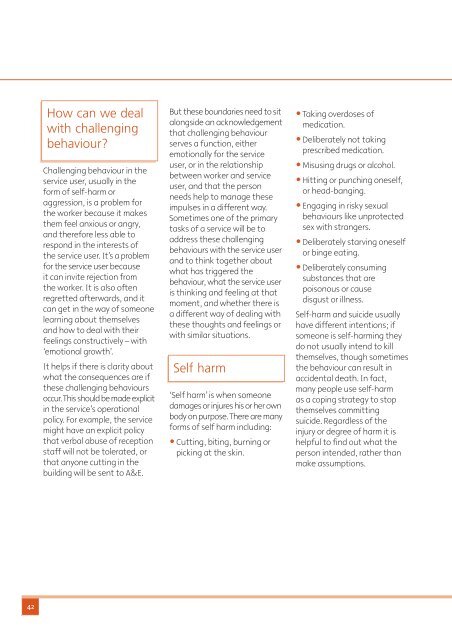Meeting-The-Challenge-Making-a-Difference-Practitioner-Guide
Meeting-The-Challenge-Making-a-Difference-Practitioner-Guide
Meeting-The-Challenge-Making-a-Difference-Practitioner-Guide
You also want an ePaper? Increase the reach of your titles
YUMPU automatically turns print PDFs into web optimized ePapers that Google loves.
How can we deal<br />
with challenging<br />
behaviour?<br />
Challenging behaviour in the<br />
service user, usually in the<br />
form of self-harm or<br />
aggression, is a problem for<br />
the worker because it makes<br />
them feel anxious or angry,<br />
and therefore less able to<br />
respond in the interests of<br />
the service user. It’s a problem<br />
for the service user because<br />
it can invite rejection from<br />
the worker. It is also often<br />
regretted afterwards, and it<br />
can get in the way of someone<br />
learning about themselves<br />
and how to deal with their<br />
feelings constructively – with<br />
‘emotional growth’.<br />
It helps if there is clarity about<br />
what the consequences are if<br />
these challenging behaviours<br />
occur.This should be made explicit<br />
in the service’s operational<br />
policy. For example, the service<br />
might have an explicit policy<br />
that verbal abuse of reception<br />
staff will not be tolerated, or<br />
that anyone cutting in the<br />
building will be sent to A&E.<br />
But these boundaries need to sit<br />
alongside an acknowledgement<br />
that challenging behaviour<br />
serves a function, either<br />
emotionally for the service<br />
user, or in the relationship<br />
between worker and service<br />
user, and that the person<br />
needs help to manage these<br />
impulses in a different way.<br />
Sometimes one of the primary<br />
tasks of a service will be to<br />
address these challenging<br />
behaviours with the service user<br />
and to think together about<br />
what has triggered the<br />
behaviour, what the service user<br />
is thinking and feeling at that<br />
moment, and whether there is<br />
a different way of dealing with<br />
these thoughts and feelings or<br />
with similar situations.<br />
Self harm<br />
‘Self harm’ is when someone<br />
damages or injures his or her own<br />
body on purpose.<strong>The</strong>re are many<br />
forms of self harm including:<br />
• Cutting, biting, burning or<br />
picking at the skin.<br />
• Taking overdoses of<br />
medication.<br />
• Deliberately not taking<br />
prescribed medication.<br />
• Misusing drugs or alcohol.<br />
• Hitting or punching oneself,<br />
or head-banging.<br />
• Engaging in risky sexual<br />
behaviours like unprotected<br />
sex with strangers.<br />
• Deliberately starving oneself<br />
or binge eating.<br />
• Deliberately consuming<br />
substances that are<br />
poisonous or cause<br />
disgust or illness.<br />
Self-harm and suicide usually<br />
have different intentions; if<br />
someone is self-harming they<br />
do not usually intend to kill<br />
themselves, though sometimes<br />
the behaviour can result in<br />
accidental death. In fact,<br />
many people use self-harm<br />
as a coping strategy to stop<br />
themselves committing<br />
suicide. Regardless of the<br />
injury or degree of harm it is<br />
helpful to find out what the<br />
person intended, rather than<br />
make assumptions.<br />
42


